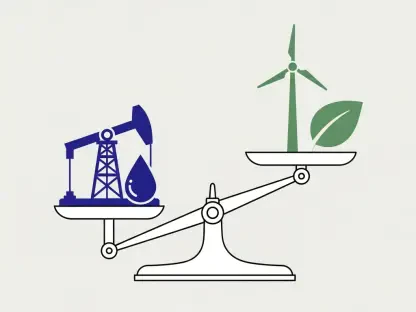Imagine a global market teetering on the edge of uncertainty, where a single policy decision or economic shift can ripple through economies worldwide, impacting millions. Oil prices, a critical barometer of global financial health, have recently stabilized after a sharp decline, caught between rising production and looming geopolitical threats. This roundup dives into diverse perspectives from industry analysts and market watchers to unpack the forces shaping oil price trends. By synthesizing expert opinions, the goal is to provide clarity on how supply hikes, demand concerns, and international trade tensions are influencing this vital commodity.
Diverse Views on Current Oil Price Stability
OPEC+ Output Increases: A Double-Edged Sword
Industry observers have noted that the decision by OPEC+ to boost production by 547,000 barrels per day in September has sparked intense debate. Many analysts argue that this move, which ended output cuts earlier than anticipated, has created an oversupply outlook, pushing prices downward. Brent crude has dipped to $68.40 per barrel, while West Texas Intermediate crude stands at $65.88 per barrel, reflecting immediate market reactions to the increased supply.
On the other hand, some experts view this production surge as a strategic response to stabilize markets amid fluctuating demand. They suggest that OPEC+ is attempting to balance the risk of losing market share against the backdrop of potential economic recovery in key regions. This perspective highlights a calculated gamble to maintain relevance in a competitive landscape.
A contrasting opinion warns of long-term consequences, with certain market watchers expressing concern over sustained oversupply. They caution that without corresponding demand growth, this increase could lock prices into a downward spiral, impacting producer nations’ revenues. These differing takes underscore the complexity of predicting oil market trajectories based solely on supply adjustments.
Demand Challenges in Major Economies
Turning to demand, there is widespread concern among analysts about weakening consumption in powerhouse economies like the U.S. and China. Reports of heightened recession risks in the U.S. have fueled fears of reduced oil usage, as economic slowdowns often correlate with lower industrial activity and consumer spending. This bearish sentiment is shaping cautious forecasts for price recovery.
In China, a shift away from aggressive policy easing toward structural economic reforms has caught the attention of market analysts. Many believe this pivot could dampen oil demand in one of the world’s largest markets, further pressuring global price levels. Such trends are seen as critical indicators that might overshadow supply-side maneuvers.
A smaller group of experts, however, suggests that these demand fears may be overstated. They point to potential stimulus measures or unexpected growth in other regions as possible counterbalances. While acknowledging the risks, this viewpoint emphasizes the need for a broader lens when assessing global consumption patterns, urging stakeholders to avoid premature pessimism.
Geopolitical Uncertainties and Trade Tensions
Geopolitical factors, particularly U.S. tariff threats on India over its significant imports of Russian oil, have introduced another layer of uncertainty. Analysts note that India’s purchase of around 1.75 million barrels per day from January to June has drawn scrutiny, yet market reactions remain muted. Many traders appear skeptical that such political posturing will lead to tangible supply disruptions.
Some industry voices argue that this skepticism reflects a growing desensitization to geopolitical rhetoric in oil markets. They suggest that unless concrete actions follow these threats, price spikes are unlikely, especially in a context of abundant supply. This perspective points to a market more driven by fundamentals than by diplomatic noise.
Conversely, a minority of experts caution against complacency, highlighting the potential for sudden policy shifts to alter trade flows in South Asia. They argue that even minor disruptions in such a significant supply chain could have outsized effects on regional energy security. This divergence in opinion reveals the unpredictable nature of blending politics with oil economics.
Market Sentiments and Broader Analyst Outlooks
Across the board, there is cautious optimism among industry analysts regarding short-term oil price stability. Many believe that until clarity emerges on U.S. policy directions, particularly concerning trade actions, the market will likely hold steady. This wait-and-see approach reflects a pragmatic stance amid multiple unknowns.
However, not all opinions align on this steadiness, with some market watchers raising concerns about unexpected demand drops or abrupt policy changes. They argue that such events could swiftly unsettle the current balance, driving volatility. This speculative angle serves as a reminder of the fragility beneath the surface calm.
Another viewpoint focuses on investor confidence, with analysts noting how these varied outlooks influence trading strategies. The diversity of predictions—from stability to sudden shifts—encourages a hedging approach among stakeholders, shaping how capital is allocated in the sector. This dynamic illustrates the broader impact of expert sentiment on market behavior.
Key Takeaways from the Oil Market Roundup
Reflecting on the insights gathered, it becomes clear that the oil market is navigating a delicate balance, with OPEC+ production hikes countering fears of demand weakness and geopolitical uncertainties. Analysts have presented a spectrum of views, from confidence in short-term stability to warnings of oversupply risks and political wildcards. For energy firms and investors, the discussions underscore the importance of monitoring economic indicators and policy developments closely. Moving forward, stakeholders are encouraged to prepare for potential supply-demand mismatches by diversifying strategies and staying updated on global trade policies. Exploring additional resources on OPEC+ decisions and international energy trends can further equip readers to navigate this volatile landscape with informed precision.









